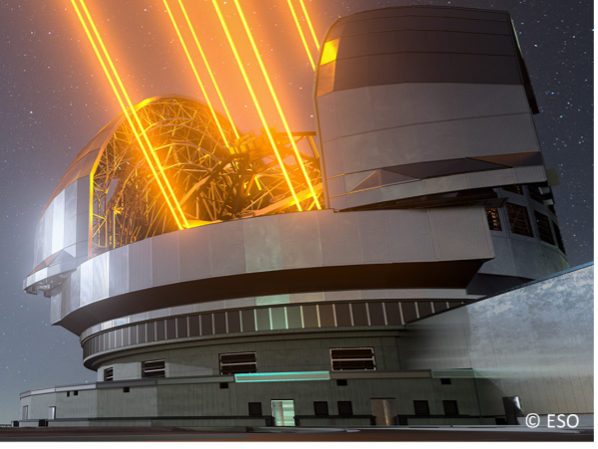Extremely Large Telescope Instrumentation
Contact: Tim Morris
The next major astronomy facility within Europe will be the 39m diameter Extremely Large Telescope (ELT). When built, this telescope will be the largest optical telescope ever constructed and will allow astronomers to see further into space than ever before. The ELT will come online towards the end of the 2020’s and will host a comprehensive instrumentation suite, each dedicated to a range of exciting science cases covering all areas of optical to mid-infrared astronomy.
The CfAI has been involved in the development of the ELT instrumentation from the inception of the ELT project nearly 20 years ago, focusing mainly on the design and performance of the adaptive optics systems that compensate for the blurring effects of the Earth’s atmosphere on astronomical images. Adaptive Optics at the ELT is also used to correct for vibrations and flexures in the 4600-ton telescope.
CfAI is currently working on the AO systems for two first light instruments, HARMONI and MOSAIC. HARMONI is a integral-field spectrograph that is capable of observing the smallest spatial scales that the ELT can observe, and providing thousands of spectra across a narrow field of view. This is used to observe a wide range of objects, from understanding distant galaxies where we use the spectral information determine their composition and determine how gas and stars are moving, or observing brighter nearby objects and image the faint planets orbiting their star. MOSAIC is also a spectrograph but it can observe over 200 objects simultaneously across a very wide field of view, albeit on not such fine spatial scales as HARMONI. MOSAIC is better suited to undertaking large surveys, sampling large numbers of faint objects to provide a more complete understanding of the types of galaxies that exist in the Universe, and how they’ve evolved over time.
Both HARMONI and MOSAIC use multiple laser and natural guide stars to measure the atmosphere distortions and telescope vibrations that blur their science images. For HARMONI, CfAI are developing some of the wavefront sensors needed to make these measurements, as well as developing the adaptive optics control system. The AO control system must process the information from all the wavefront sensors in HARMONI, and then calculate how to distort the adaptive optics mirrors in the system to correct for the observed distortions. It does this up to 1000 times a second, with very low processing latencies making it one of the most challenging and complex pieces of software within the entire observatory. For MOSAIC, Durham is the lead institute for the wide-field “Ground-layer” AO system that provides the AO correction across the full field of view of the telescope. HARMONI and MOSAIC are expected to be on-sky within a few years of the ELT first light.



/prod01/prodbucket01/media/durham-university/departments-/physics/cfai/CfAI-Webpage-Banner-smaller.jpg)